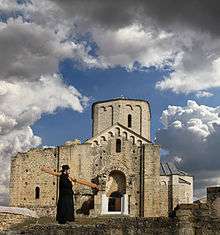Stari Ras
| Stari Ras | |
|---|---|
|
Native name Serbian: Стари Рас | |
|
Overview of the Stari Ras | |
| Location | Near Novi Pazar, Serbia |
| Coordinates | 43°7′42″N 20°24′56″E / 43.12833°N 20.41556°ECoordinates: 43°7′42″N 20°24′56″E / 43.12833°N 20.41556°E |
| Elevation | 755 m (2,477.0 ft) |
| Official name: Stari Ras and Sopoćani | |
| Type | Cultural |
| Criteria | i, iii |
| Designated | 1979 (3rd session) |
| Reference no. | 96 |
| State Party |
|
| Region | Europe and North America |
| Official name: СТАРИ РАС СА СОПОЋАНИМА | |
| Type | Monument of Culture of Exceptional Importance |
| Designated | 1990 |
| Reference no. | ПКИЦ 24[1] |
 Location of Stari Ras within Serbia | |
Ras (Serbian Cyrillic: Рас, Latin: Arsa), known in modern Serbian historiography as Stari Ras (Стари Рас; meaning Old Ras), was one of the first capitals of the medieval Serbian state of Raška, and the most important one for a long period of time. Located in today's region of Raška, the city was right in the centre of the early medieval state that started to spread in all directions. It was founded between 8th and 9th centuries and got deserted sometime in the 13th century. Its favorable position in the area known as Old Serbia, along the Raška gorge, on the crossroads between the Adriatic Sea and state of Zeta, Bosnia in the west and Kosovo in the east added to its importance as a city. There is an impressive group of medieval monuments consisting of fortresses, churches and monasteries. The monastery at Sopoćani is a reminder of the contacts between Western world and the Byzantine world. Today the city lies in mostly unenclosed and unprotected ruins close to the city of Novi Pazar, which probably began its own life as a trading enclave for Ras. However, there are plans for future reconstruction of the site. The site of Stari Ras, in combination with the nearby Monastery of Sopoćani, is already a UNESCO World Heritage Site, and Stari Ras monastery (12th century) is being reconstructed and it too may be included on the UNESCO World Heritage List with the site. Stari Ras and Sopoćani World Heritage site is not far from another UNESCO World Heritage Site of Serbia, the magnificent medieval monastery and churches of Studenica. The 4th century Church of Saint Apostles Peter and Paul is one of the oldest in the Balkans.
Stari Ras was declared Monument of Culture of Exceptional Importance in 1990, and it is protected by Republic of Serbia.[1]
History
With the arrival of Slavs beginning in the 520s, the Byzantine (Roman - "castellum of Arsa") town Arsia soon became a peripheral place for Serbia, as it served as the capital in the early and high Middle Ages (ca 880-960). In the early stages of Serbian statehood it was the easternmost town, bordering the First Bulgarian Empire, also annexed by the Bulgars in 924-927.
The oldest church-building in Serbia, the Church of Saint Apostles Peter and Paul, was founded in the 8th century on foundations of an Early Christian church dated to at least the ruling period of Emperor Constantine (306-312).[2] Serbian Prince Petar Gojniković (r. 892-917) was entombed in this church.[3]
A Serbian bishopric may have been founded in Ras as early as 871 during the rule of Serbian Prince Mutimir, confirmed by the Council of Constantinople in 879-80.[4]
Byzantine Emperor John I Tzimiskes (r. 969-976) recognized the Ras region as being the focus of the Serbian lands.[5]
After the fall of the Bulgarian Empire (1018), Ras became the political center of Serbia. In the chrysobulls of Basil II dated to 1020, the Ras bishopric is mentioned as serving the whole of Serbia, with the seat at the Church of Saint Apostles Peter and Paul. Ras was part of the Ohrid archbishopric (1029), and was briefly seat of the Ras catepanate, a Byzantine administrative unit of the conquered Serbian territories. During the first Hungarian-Byzantine War (1127-9), the Serbs fought on the Hungarian side, re-conquering Ras which had been under Byzantine rule. In the next war (1149–51) the Byzantines seized Ras again.
A late 12th-century cave monastery existed in the region north of the Studenica monastery.[6]
-
Petrova Church, 8th century
-

Đurđevi stupovi, 12th century
-

Sopoćani, 13th century
See also
| Wikimedia Commons has media related to Stari Ras. |
- Monument of Culture of Exceptional Importance
- Tourism in Serbia
- Nemanjić dynasty
- Spatial Cultural-Historical Units of Great Importance
External links
References and notes
- 1 2 Monuments of Culture in Serbia: СТАРИ РАС СА СОПОЋАНИМА (SANU) (Serbian) (English)
- ↑ Mitchell, Laurence (2007). Serbia. Bradt Travel Guides. Retrieved August 30, 2012.
- ↑ CHRONICLE OF THE PRIEST OF DUKLJA (Ljetopis' Popa Dukljanina)
- ↑ http://books.google.com/books?id=fpVOAAAAIAAJ
- ↑ http://books.google.com/books?id=GpQ3AAAAIAAJ
- ↑ http://books.google.com/books?id=O4pj9YNdgJYC
- Mrkobrad, D. 1997, "Ras-Postenje: Phases in the development of the fortress", Zbornik radova Vizantološkog instituta, no. 36, pp. 203–219.
- The Serbs
| ||||||
| ||||||||||||||||||||||||||||||||||||||||||||||
| ||||||||||||||||||||
| ||||||||||||||||||||||

